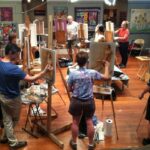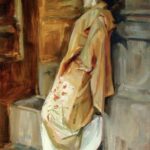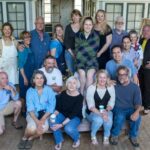
E. Melinda Morrison
20 x 20
Over the past few months, I worked hard at putting together 10-12 strong paintings for a two-person show at my gallery in Santa Fe. I did my best and felt proud of the work I presented all the while knowing that walking into a show right before a presidential election was unpredictable in sales outcome. While the show was well attended and many people handed out well-meaning compliments on the work, sales have been slow to come.
I suspect many artists feel embarrassed by the outcome of a poor sales show and struggle with the temptation to doubt their own artistic capability. Over the years, I discovered lack of sales does not name you as an artist. Quality does not always convert to sales. However, despite doing our best work, it is disconcerting when sales are low. Yes, it can be disappointing at first but then perspective comes to the rescue. I thought I would share some perspective I’ve gained from my process over the years for sluggish sales.
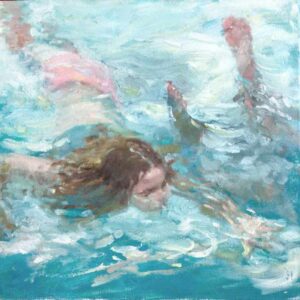
E. Melinda Morrison
24×24
1. Don’t doubt yourself. It’s tempting to doubt your artistic capabilities when sales are slow and many artists find themselves grappling with this. One of the buffer’s I have found against this is putting quality at the forefront for producing your work. Showing only quality work is a rock you can stand on and gain confidence as an artist.
2. It has happened to the best and worst of us. A well-known master painter, who is a close friend of mine, use to sell-out his one-man shows before the opening night. Years ago, when he had another solo show, a fraction of his paintings sold despite his beautiful work. While disappointed, he had great perspective and said “it happens and I did my best but the paintings will eventually sell.” And they did, it just took a while longer than the time frame of the show.

E. Melinda Morrison
20×24
3. Change what is in your control. While there are things that are out of our control when selling our work, look at the things that are within your control. Having spent many years in advertising and marketing before my art career, I am well aware of the aspects of marketing that drive sales, and the hard work and effort to keep your name out in front of collectors. Staying connected to the art public means using the tools available to you: social media, print advertising, PR, email, blogs, and participation in credible regional, national and museum shows to build your brand. Lucky are those artists who do not have to do this work, but my experience is for most artists, even the most talented nowadays, it requires effort on both the part of the gallery and the artist to maintain exposure and visibility among collectors.
4. Let go of what you cannot control. Election years, stock market fluctuations, oil prices, downturn in the economy, violence in the world will always be with us in one degree or another. I’ve learned I cannot use the barometer of swaying winds in the art market to determine the outcome of who I am as an artist. I have to let that go and show up at the easel. The power of the easel can be the calm during a storm and my faith in God helps me to let go allowing the creative process to continue on. Deep breathing, massages, exercise and a lot of prayer along with pep talks among artist friends helps too!
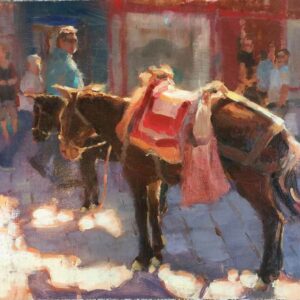
E. Melinda Morrison
12 x 12
5. Use a negative as a fulcrum for a positive outcome. I am that kind of person if you say I can’t do something, I set my course for figuring out how to do it, i.e. prove myself over again as an artist, taking action to sharpen my mechanics. I explore, stretch my skills and experiment in my work, scrapping lots of paintings and tackling an area in my work that needs strengthening. I find inspiration where it can be found and I dive into that, but mostly, I just keep painting!
“Be like an oak tree that weathers a storm. It may loose some limbs and leaves, but it is mostly in tack to live on and grow stronger,” from an unknown wise source.
Keep painting!
Oil Painting
Plein Air Painting is the New Golf

Golf and painting are challenging and fun but they are also frustrating. In golf, some days you’re hitting the ball like a pro and other days you’re just shanking and slicing from the rough to the sand traps and back. Painters have the same problem: some days the stars align and the painting just flows. More often you’re struggling, desperately trying to get it on canvas. Both painters and golfers wonder who snuck into the garage at night and switched out all of our equipment.


The gods of both golf and painting play the same game with your head: when you’re just about to give up and throw your clubs in the lake or your paints in the trash, the gods give you a birdie or a sweet painting and pull you back in (think of Al Pacino in the Godfather). Painting has mental sand traps as challenging as the ones on the golf course. There are techniques for “getting out” but it takes lots of study and practice.
Weather is a factor. Both golfers and painters hate wind and rain. Some golfers use brightly colored balls to play in the snow. Some painters keep their white paint in their pockets so it won’t freeze in the snow. Both activities also require special umbrellas and clothing. Oh boy, an excuse to buy more stuff!
Lots of doctors and lawyers play golf and I’m meeting more and more doctors and lawyers in workshops. They’re focused, determined and have the latest top-of-the-line stuff. Men dominated both activities in the beginning, but now women want to be frustrated, I mean challenged, too.

Travel to new places is exciting for both golfers and painters. Vacations to golf courses all over the world are very popular. Then golfers gather at parties, drink and compare notes on the courses they’ve played. Artists love to travel to paint, drink and compare notes on where to find turpentine in foreign countries. Travel gear is a challenge for both activities. Golf clubs are bulky and may incur extra airline charges. Paints, tripods and other painting gear require special packing and cannot be carried on. Both groups hold their breath until their precious cargo appears on the baggage ramp at their destination. Phew–there’s my bag!
When I was growing up my parents used to joke that they were spending our inheritance on golf clubs, shoes and paraphernalia. There was always a new gadget or golf ball that would improve their game. An entire side of our garage was devoted to golf stuff. Painters have the same opportunity to taunt their kids with how much money they’re spending on “stuff.” Exciting conventions offer tempting new paints, brushes, view finders, frames and videos that will change our “game.”

My mom took golf lessons for 40 years. She would be convinced that each new golf pro was “the best ever” and was going to lower her handicap. (There’s a thought: why don’t artist’s have handicaps? it would make sense when signing up for workshops, entering shows, etc. “Artists with a handicap above 12 need not apply.”) Back to my mom: she took copious notes in little spiral notebooks, bought books by masters like Arnold Palmer and Gary Player, and watched golf TV on weekends. I have dozens of sketchbooks with workshop notes and, like my mom, am convinced that each new instructor’s palette choices, etc., are just what I needed to conquer the art. The painting videos are endless and serve 2 purposes: they instruct and entertain, just like the golf TV did for my folks. Unlike my parents’ golf TV shows, I can pop a DVD in or even download a YouTube demo any time I want, not just on weekends. (Here’s a personal note to my kids: you can toss it all when I’m gone.)

Golfing buddies or artist buddies: if you’re lucky, you’ve got ‘em. The best friends will encourage you when you’ve had a lousy day and you’ll do the same for them. The shared experience, whether on the golf course or on a painting site will be revisited again and again. “Remember that time we…(were caught in a monsoon on the 9th hole…were chased by a bear while painting in Yosemite…)? Speaking of friends, golfing buddies or artist buddies, they’re the best!

Whether you’re a professional or not, standing on the first tee looking out at a sea of green grass or you’ve set up your easel on a dock with a view of the Aegean sea, every beginning is filled with hope and the joy of just being out there in the fresh air. You smile at your buddies, pick up your driver or brush, and go for it.
Eve Albrecht Interview with Kevin Macpherson OPAM

by Kevin Macpherson OPAM
Describe your path as an artist.
The earliest memories I have of my childhood are drawing on my grandfather’s porcelain kitchen table. He would teach me how to draw rabbits and turtles, and we were able to magically wipe the pencil marks off without ruining the table or getting in trouble. I also remember eagerly drawing portraits of Lincoln and Kennedy from the little matchbook ads. My childhood was focused on art, drawing, painting and modeling clay. I remember by the time I was seven years old, I would dedicate my life to art. It was the best thing to do for me and my life. I was always the best artist in my classes, however, I never had someone to guide me into what a career as an artist may be.
Although art was always the center of my life, and I knew I would be a professional artist by the time I was seven, I never had formal training until I went to Northern Arizona University. Fortunately, as I majored in illustration, I had a wonderful instructor named Chris Magadini. He was an inspiring instructor who encouraged the best from his students. He became my first mentor, and we remain friends and painting peers to this day.
My training as an illustrator and my eight years as a freelance illustrator was an excellent foundation for a fine artist. The skills necessary for working in the demanding advertising field honed the skills that now continue to influence and execute my paintings. I continued my studies at the Scottsdale Artists’ School, taking workshops from many fine artists. In addition to my training as an illustrator, my eyes were awakened to the new world painting on location. The countless hours outside, directly observing nature and color, taught me truly how to see as an artist. This directly influenced my illustration work, but more importantly, it impassioned need for me to continue painting from life, en plein air and for myself. I worked as a freelance illustrator from 1979 to 1987. Since 1987, I have made my living painting, writing books and teaching occasional workshops.
From the time I learned how to hitch hike around the country without more than a few dollars in my pocket, I was always an impassioned traveler. I have traveled most of the world. New places and faces have inspired my work and my whole career. New unexpected places keep me curious. Every day feels like a vacation. On vacation, one’s senses are at their highest level. An artist needs to be sensitive, so for a plein air artist, travel is a perfect companion. I spend months at a time away from home, painting every day, visiting museums and experiencing the lifestyle of many different cultures. Art is a universal language that opens many doors in every place I go.
How would you describe your work to someone who’s never seen it?
Impressionistic realism. I am a plein air painter depicting nature’s color, light and atmosphere. My paintings are based on nature’s color relationships. I find visual poetry in the combinations of color. Honed by years of acute observation, my eye has been sensitized to look for beauty in natural subjects. This beauty is revealed by light, filtered through atmosphere and colored by my mind. The landscape is my favorite subject. I strive to express qualities in nature that are universal, without using formulas. People comment that they leave my paintings with a good feeling. This tells me I have created a bridge between the mind of the painter and that of the viewer. My enchantment with color and light is the genesis for my paintings, and, of course, travel offers inexhaustible sources for subject matter.

by Kevin Macpherson OPAM
What ideas do you explore in your work?
I seek to find the relationships of color and value and the light and atmosphere that makes each moment unique, special and transitory, just as life’s moments are as precious. Plein air painting is an act of being present. I believe my paintings represent four dimensions. The illusion of reality on a flat surface, but also the fourth dimension of time. The shadows represent the past, the light the future and where they meet is truly the only moment of present.
I paint the space, the air between me and the subject. This space is different all the time, being filtered by light, color and atmosphere. Each day, each moment will have different combinations and different relationships of values and color. I must observe directly and very carefully to find these relationships that make each painting unique.
What do you want people to know about your work?
It is for sale.
Where do you find inspiration?
What inspires me most is color, light and atmospheric effects. Nature offers me infinite combinations. I actually do not know what the next motif will be. I must always be on call and be aware of my surroundings and accepting of the many opportunities that nature puts before me. The combination of colors and value patterns, clear air or dense air, the light of the evening sun or even the glare of high noon may inspire me. I live in a beautiful rural area, high in the mountains east of Taos, New Mexico, surrounded by pines, aspens and animals. The beautiful changing seasons have inspired many of my paintings, including my series of 368 paintings called “Reflections on a Pond.” This series really sums up what my painting is all about. It’s not so much about a beautiful subject out my window, but the ever-changing light and atmosphere and compositional opportunities that nature puts forth.
Once you become sensitive to nature’s effects, anything in any place will become inspiring. You will find that the land has not changed, rather, it is your eyes that have changed. The world is filled with colorful locations right outside your backdoor. Commune with nature in a familiar spot. See it again… for the first time. When painting from life, we have a direct connection with the subject. We see more clearly, and we feel the subject with all our senses.
Which artists living and master artists inspire you?
I have always been drawn towards the impressionists; French, Russian, American, especially Californian impressionists. Specifically, Monet, Andrew Wyeth, Nicolai Fechin, Sorolla and the American illustrators, Pyle, Cornwell, Rockwell and Calligraphy. Now with the internet, we have so many artists to see at the click of a button. There are so many living artists and past artists that I admire who were representational and abstract painters and sculptors.
In fact, finding your own voice and trusting and believing in yourself and what you have to offer is one of the most important things you could do for yourself as an artist. There are so many good artists available to look at, to compare and to persuade you to copy. All the great masters were humans, and yes, they are great, and we put them on a pedestal, but each of you has something worthy and unique to say, and if you can believe in yourself, you have a chance of becoming a very fine, successful artist. If you could paint like any artist in the world, who would that be? There is really only one answer, that is Y O U.

by Kevin Macpherson OPAM
What’s your workspace like? When and where do you like to create your art?
Well, as a plein air artist, I have travelled, painted and taught classes in over thirty-five counties, so my workspace is outdoors, within grand landscapes and exciting cities around the world. I have had a love for travel since I was a young man, and fortunately, I can work (paint) wherever I go. I have a beautiful, large studio beside my home in the mountains of Taos, New Mexico. Our property borders the national forest. It is a tranquil environment that offers a respite from my world travels and a busy social lifestyle. We are presently building a new home and studio in Baja, Mexico with a view of the Sea of Cortez. The last two months, I had a temporary studio in Guangzhou, China, preparing large paintings for my “Reflections on a Pond” exhibit which is presently on Museum tour in China.
What does a typical work day/week look like when you are working on your art?
I often work or play in splurges. Winter skiing may take me away from painting for a while, as does teaching a workshop or judging a show. Writing a book takes a lot of determination and an enormous block of time, all of which takes away from the actual painting. I enjoy the mix of other creative pursuits to mix it up. Painting excursions away from home are usually a very focused time for a month or two, painting everyday. I usually work on dedicated projects for blocks of time.
We obviously have many things we need to do to survive, such as care for our families and all the work related for a career in art, as it is much more than just painting. Painting can be meditative and also very demanding hard work and exhausting. This month I am painting large works for my show, working ten to twelve hours a day. I must tell you, I am very tired but hope to be rewarded with good work accomplished. A good three to six hours a day of concentrated practice and playful painting will often be the norm. Hours can disappear when you are enjoying painting. Inspiration will find you if you work a little everyday. A professional painter goes to work everyday. You can’t just wait to be inspired. That only happens in a movie about a crazy artist.
How do you prepare for a new project (process)?
I usually have many ideas brewing and doing at once, but eventually, each project takes precedent, and after great procrastination, I focus and work intense hours, weeks, months, whatever it takes to get it done.

with Kevin in China
What is your next project?
I just had my third art instructional book published. “Light, Atmosphere and Color,” the first edition, is published in the Chinese language. I will print an English version that should be available at the end of this year.
Our lives have been blessed with the art spirit. Because of this, recent years have found me in Mexico, Guatemala and China volunteering and offering art opportunities to underprivileged children. I have created a non-profit foundation: Artamabassador.org. The universal language of art crosses all borders. My hope is that children will have the chance to dream in color. This project has not only already drawn smiles on many children but also on my own face.
What challenges do you face as an artist?
Time. Time to do all of the things that I’d like to accomplish. I realize life is short. Finding the balance to do what I want and learn to say no to distractions is a goal.
What are your artistic goals?
This past decade, I have ventured on my own in China for inspiration. This unfamiliar land, language and subject matter have reignited my artistic fire. I have been totally out of my comfort zone, and I love it. Inspiration comes at unexpected times and places. I need time, some quiet time, to let my mind wander and wonder. I am commissioning myself to create and encounter novel ways of thinking and challenging myself to new subject matters with permission to fail. We must challenge ourselves with new ideas and embrace change. Change is at the core of progress.
Travel to Asia has surprisingly shifted my gears. I went as a landscape painter, but I was so inspired by the people and faces of China that I began painting portraits and figurative works. I find this subject very challenging. An artist must go with inspiration wherever that leads. It takes years and years to master the skills necessary to communicate inspiring works of art. It is also a danger to become too comfortable repeating one’s success. It is interesting that we work so hard to figure out how to do it, but when we reach that place of knowing, most artists I admire will raise the bar and find new challenges. Curiously, it is finding something new searching for the unknown that motivates an artist. There can be many obstacles and discouragements along the way, but if a person follows their dream, it will never feel like work. If you’re not self motivated, one will never ever reach full potential.

with Kevin in China
Tell us something surprising about your creative process or your working style.
Because of my interest in China and the culture, I am learning Chinese and learning the written language as well. I can now recognize and understand with deeper meaning what this wonderful county has to offer. Although my language skill is still elementary, my brush and colors can communicate my joy of life, the joy of creativity that colors everything else we do in life. Many children with whom I volunteer live in rural areas that don’t have the opportunity for art and creativity. I hope my small contribution as Artambassador may make a difference one stroke at a time. What I teach as an Artambassador is that being an artist is not always easy or practical but it starts with pure joy. Art is an inherent gift, but this gift must be unwrapped. It starts with play but takes endurance, discipline and hard work. Art fuels oneself for a lifetime of study and curiosity. Perhaps being an artist will not be their job, but it will influence how they react in their world with others and influence how they solve problems.
It all starts with design
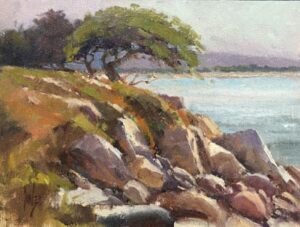 Way back in graduate school we were taught the importance of designing our drawings in such a way to influence the viewer’s eyesight so it traveled through the drawing and picked out the most important elements before moving on to the next drawing or piece of manuscript. At the time I was training to become a medical illustrator and our audience was surgeons who were studying how-to manuals for performing various surgical procedures. Our drawings were step-by-step instructions on how to do everything from an aortic valve replacement to brain surgery.
Way back in graduate school we were taught the importance of designing our drawings in such a way to influence the viewer’s eyesight so it traveled through the drawing and picked out the most important elements before moving on to the next drawing or piece of manuscript. At the time I was training to become a medical illustrator and our audience was surgeons who were studying how-to manuals for performing various surgical procedures. Our drawings were step-by-step instructions on how to do everything from an aortic valve replacement to brain surgery.
The attention span of our audience was very short but we were taught the reader was much more likely to remember a series of drawings showing a surgical procedure than mountains of text. Little did I know how important that training would become as I pursued my current artistic endeavors. What I learned is simple…it all starts with design. Mother Nature is a really good designer but sometimes she needs a little help when it comes to painting her likeness on a canvas.
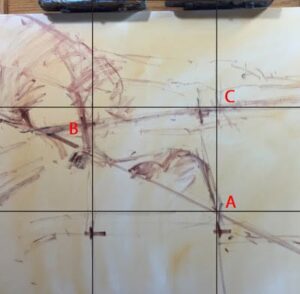 To demonstrate what I mean I photographed a recent painting from start to end. By following me through the steps I hope you will come to understand that there is more to copying a landscape to canvas. You must engage the viewer and you do that with design, color and controlling the viewer’s gaze. As is my custom I will be painting from the field study I painted on a trip to Carmel a couple of summers ago.
To demonstrate what I mean I photographed a recent painting from start to end. By following me through the steps I hope you will come to understand that there is more to copying a landscape to canvas. You must engage the viewer and you do that with design, color and controlling the viewer’s gaze. As is my custom I will be painting from the field study I painted on a trip to Carmel a couple of summers ago.
On a 24″ x 30″ canvas I begin my design by dividing the canvas into thirds ending up with nine equal squares. My objective is to arrange the elements of the landscape in such a way that the viewer’s eye will be in constant motion and to do that I purposely place objects where the horizontal and vertical lines intersect.
At “A” the base of the rock lands exactly on the crossing lines. The angled line runs from “A” towards “B”. At “B” the vertically angled tree takes you up to the intersecting top third line. The shoreline runs from “B” to “C” where the base of the cliff lines up with the right side vertical line and also lines up with the right side of the main boulder back at “A”. The next drawing shows how the eye moves around the painting.
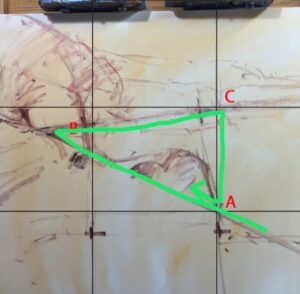 The plan is to have the viewer enter the painting at “A”, visually travel to “B” over to “C” then back down to “A” where the process starts over. If I pull this off the viewer will become engaged and visually travel through my entire painting.
The plan is to have the viewer enter the painting at “A”, visually travel to “B” over to “C” then back down to “A” where the process starts over. If I pull this off the viewer will become engaged and visually travel through my entire painting.
You still with me?
Next I lay in a halftone drawing using a reddish wash to give myself a better look at the design before I commit to paint. I decide I need a “visual block” to keep the viewer from sliding off the right side of the canvas so I add a large dark boulder at the bottom right. I will add a dark element to the lower left of the painting to give it some balance. I’m thinking a dark bush of some sort.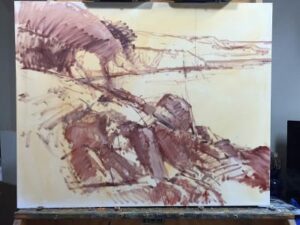

I put in my darkest darks in the foreground and paint the main tree. Then using the foreground values as my guide I put in the distant cliffs. Using my plein air sketch as my value guide I continue to move around all parts of the canvas bringing the distant cliffs, middle ground trees and foreground rock formation all up at the same time.
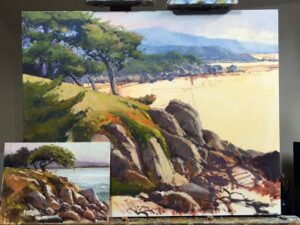
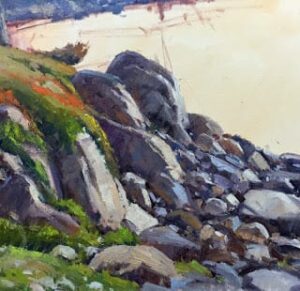
Detail of the foreground rocks
This was a blast to paint. Most of it is made up as I go, changing colors and shapes of the rocks to give it an organic feel.
The finished painting, or so I thought
Once this was finished I put it in a closet for a month and did not look at it again until this morning. Once it was back on the easel I felt something was missing.
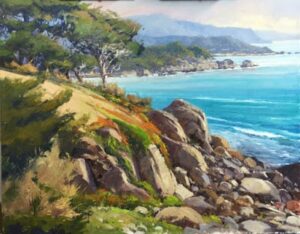
I decide it needed something else to draw the viewer away from the rock pile and up the hill to my center of interest. By adding a splash of color on the hill representing the poppies and other wild flowers that grow on the coast I believe the painting is now finished.
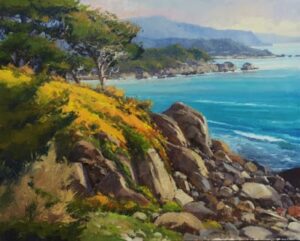
Learning never exhausts the mind…
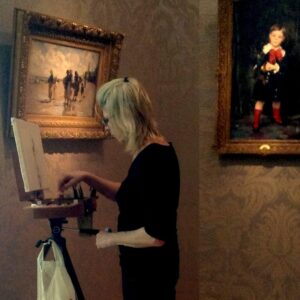
This quote by Leonardo da Vinci may seem contradictory to anyone who has endeavored to learn the skills necessary for representational painting. Whether a student or seasoned artist, the process of learning will test your patience to the point of insanity. Even Sargent had his difficulties, and issued forth a sort of battle cry of “demons, demons,” with which he would dash at his canvas.
Patience is a crucial element in learning to paint. One of the most encouraging things I learned was from Richard Schmid. His belief that painting is a craft which requires practice but above all patience, really set me free from negative thoughts. Much like learning to play the piano or becoming a champion athlete, it’s important not to blame ourselves when our skills don’t quite match our visions. Another mentor was John Terelak, the great Cape Ann painter and instructor. At that point in my journey, I felt my work was not good enough to share with the public and John instilled in me the need to believe in myself. He explained that learning is a life-long pursuit, our work is ever evolving and improving – your best effort is all that’s required.

“I do not judge, I only chronicle.”
I will never forget my first painting event, I was in way over my head but felt I should challenge myself. In spite of this, I must’ve looked like I belonged there as a fellow painter soon joined me at my chosen location. I was lucky that she quickly recognized that I had no idea what the hell I was doing. With some helpful tips I was able to make it through the day and although my painting was amateurish I was hooked on painting outdoors.
After nearly 30 years at the easel, I continue to have moments of frustration and self doubt. It sometimes feels as if the more I know, the less I realize I know… if you know what I mean. These moments of fear and doubt can lead to a creative block. Sometimes we spend more time gaining theoretical knowledge and not enough time actually painting. Nearly every artist I know has gone through this and the best way to overcome it is to push through and keep painting. When our skills become intuitive much like muscle memory, then our ideas and the execution of those ideas are synthesized.

Developing patience requires having faith that eventually, you will get there. Seek out the support and exchange of ideas of fellow painters, especially those who are on the same creative path, and learn from their mistakes and successes. Celebrate small victories and breakthroughs when you’re learning the process, and allow those achievements to get you to the next level.

Recently, I felt the need to return to a more academic approach to painting by attending the Academy of Realist Art in Boston. The Academy teaches traditional techniques, modeled on 19th century French academies. The focus was on creating the color study which is a preliminary oil sketch that determines specific colors and establishes, in the most simplified manner, the value range that will best achieve a light effect and create volume. It gave me a greater understanding of how to simplify planes, properly compose values and create color harmony. The Academy proved to be exactly where I needed to be in order to hone my draftsmanship and painting skills. So never feel as though you’ve moved beyond a specific level, it’s always good to revisit the fundamentals.
Paint from life as often as you can and carry a sketchbook with you at all times. Changing disciplines from portraiture to landscape, still life to painting the figure is also beneficial as each provides something different to consider in terms of design, form, value and color.
I visit museums often and carry a sketch book to “deconstruct” or make value studies of masterworks. So much can be learned from this practice. I also attend artist demonstrations and visit the studios of painters I admire whenever an invitation is extended.
“Cultivate an ever continuous power of observation…
be always ready to make slight notes of postures, groups and incidents”
In regards to workshops, choose someone who embodies your values and approach to painting. Nearly 20 years ago I studied with a wonderful teacher who felt that taking workshops with seasoned (or celebrity artists as he called them) was like trying to pick up a “bag of tricks”. Although this is true to some degree, watching a master painter at work is a tremendously useful way to learn. Just be careful not to be so influenced as to believe that technique or mannerism is the path to good painting. Honesty is the true path to yourself and your own expressive voice.
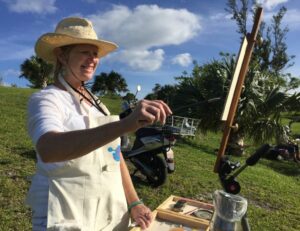
“Above all things get abroad, see the sunlight and everything that is to be seen.”
As many of you know I love to travel and just returned from teaching a workshop in Italy. For me, there is no better way to arouse the senses than through visiting new places. Travel offers a diversity of landscapes, architecture and people. It’s always an awe-inspiring and enriching experience and a sure way to break free from old habits.
For more information, please visit my website www.elicedrone.com
All quotes by John Singer Sargent
